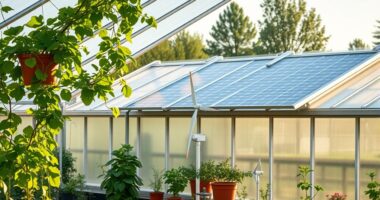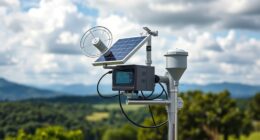Self-learning systems for light and temperature optimization use sensors to gather real-time environmental data and adaptive algorithms that analyze patterns over time. They adjust lighting and climate settings automatically, balancing occupant comfort with energy savings. These systems learn from usage habits and environmental changes, continuously improving their responses. If you want to discover how these intelligent solutions can transform your space, keep exploring further.
Key Takeaways
- Integrate diverse sensors to gather real-time data on light, temperature, motion, and humidity.
- Utilize adaptive algorithms and machine learning to analyze data and optimize environmental settings continuously.
- Implement feedback loops that learn from environmental changes and occupancy patterns for improved system responses.
- Enhance energy efficiency and occupant comfort by dynamically adjusting lighting and temperature based on learned preferences.
- Support sustainable building management through proactive, automated environmental control that reduces manual intervention.

Imagine a system that continuously learns and adapts to enhance lighting and temperature in real-time, creating a more comfortable and energy-efficient environment. This kind of self-learning system hinges on seamless sensor integration, which involves connecting various sensors—such as light sensors, temperature sensors, motion detectors, and humidity sensors—so the system can gather accurate, real-time data about its surroundings. These sensors act as the system’s eyes and ears, providing detailed information that enables it to make informed adjustments. When sensor data indicates changes in ambient light levels or temperature, adaptive algorithms analyze this information instantly, deciding how best to respond to maintain ideal conditions.
The core strength of these systems lies in their adaptive algorithms. Unlike traditional HVAC or lighting controls that rely on preset schedules or manual adjustments, self-learning systems use machine learning techniques to interpret sensor inputs continuously. These algorithms learn from patterns over time, recognizing, for instance, how natural daylight varies throughout the day or how occupancy levels fluctuate in different areas. As a result, the system becomes smarter, fine-tuning lighting brightness or temperature settings dynamically, without requiring human intervention. Over time, this adaptation leads to more personalized comfort levels and significant energy savings, since the system minimizes unnecessary adjustments and power consumption.
You’ll notice that sensor integration plays a crucial role here. When sensors are properly integrated, the system can respond swiftly to environmental changes—whether it’s a cloudy day reducing natural sunlight or a sudden drop in temperature. The adaptive algorithms process this influx of data in real-time, learning from each event to improve future responses. For example, if the system detects that a particular room is frequently unoccupied during certain hours, it can automatically lower lighting and temperature settings during those times, conserving energy without sacrificing comfort when the space is in use again. This continuous feedback loop allows the system to evolve and optimize its performance, reducing waste and enhancing user comfort simultaneously.
Additionally, understanding projector technology can be beneficial when designing spaces that incorporate smart environmental controls, as the proper setup can significantly affect overall comfort and efficiency. In essence, these self-learning systems transform how buildings manage their internal environments. By leveraging sensor integration and adaptive algorithms, they provide a proactive approach to energy efficiency and comfort. You don’t need to constantly tweak settings or rely on fixed schedules; instead, the system learns from your habits, environmental conditions, and usage patterns. As a result, you enjoy a space that feels just right—bright and warm when needed, dimmer and cooler when appropriate—all while consuming less energy. This intelligent, responsive technology represents a significant step forward in sustainable building management, making your environment smarter, more efficient, and truly attuned to your needs.
Frequently Asked Questions
How Do Self-Learning Systems Adapt to Seasonal Changes?
You’ll notice that self-learning systems adapt to seasonal changes by using adaptive algorithms that adjust their settings based on environmental data. Sensors gather real-time light and temperature info, and the system calibrates these sensors regularly to guarantee accuracy. This continuous process allows the system to fine-tune lighting and temperature controls, maintaining ideal conditions regardless of seasonal variations, and ensuring your environment stays comfortable and energy-efficient year-round.
What Are the Main Challenges in Implementing These Systems?
You face challenges in implementing these systems, mainly ensuring algorithm robustness and data privacy. Robust algorithms must adapt to unpredictable environmental changes without errors, which is complex. You also need to protect user data, complying with privacy regulations and preventing breaches. Balancing these factors demands careful design, ongoing monitoring, and secure data handling, making deployment more intricate but essential for reliable, trustworthy self-learning systems.
Can These Systems Integrate With Existing Building Automation?
Yes, these systems can integrate with existing building automation, but you might face integration challenges like compatibility issues and data privacy concerns. You’ll need to guarantee the new system communicates smoothly with your current setup and safeguards sensitive data. Addressing these challenges early helps you streamline installation, enhance energy efficiency, and optimize comfort without disrupting your building’s operations. Proper planning makes integration more manageable and effective.
What Is the Typical ROI for Deploying Self-Learning Optimization?
You can expect a solid ROI from deploying self-learning optimization systems, often within 1 to 3 years. Conducting a cost analysis reveals significant energy savings, which directly reduce your operational expenses. These systems continuously adapt, optimizing light and temperature settings to cut waste and improve comfort. Over time, the combined savings on energy bills and maintenance costs outweigh the initial investment, providing long-term financial benefits.
How Do These Systems Ensure User Comfort and Satisfaction?
You guarantee user comfort and satisfaction by implementing personalization strategies that adapt lighting and temperature to your preferences. The system actively learns from your feedback, adjusting settings to better suit your needs over time. It monitors your interactions and responds accordingly, creating a seamless experience. This dynamic approach guarantees your environment remains comfortable, while continuously improving based on your input, making your space more personalized and satisfying.
Conclusion
As you explore the potential of self-learning systems, one thing becomes clear: the future of light and temperature optimization hinges on their ability to adapt in real time. But what surprises lie ahead? Will these systems fully master environmental control, or will unexpected challenges push them to their limits? The journey is just beginning, and the next breakthrough could transform how you interact with your surroundings—if you’re ready to embrace what’s coming next.








